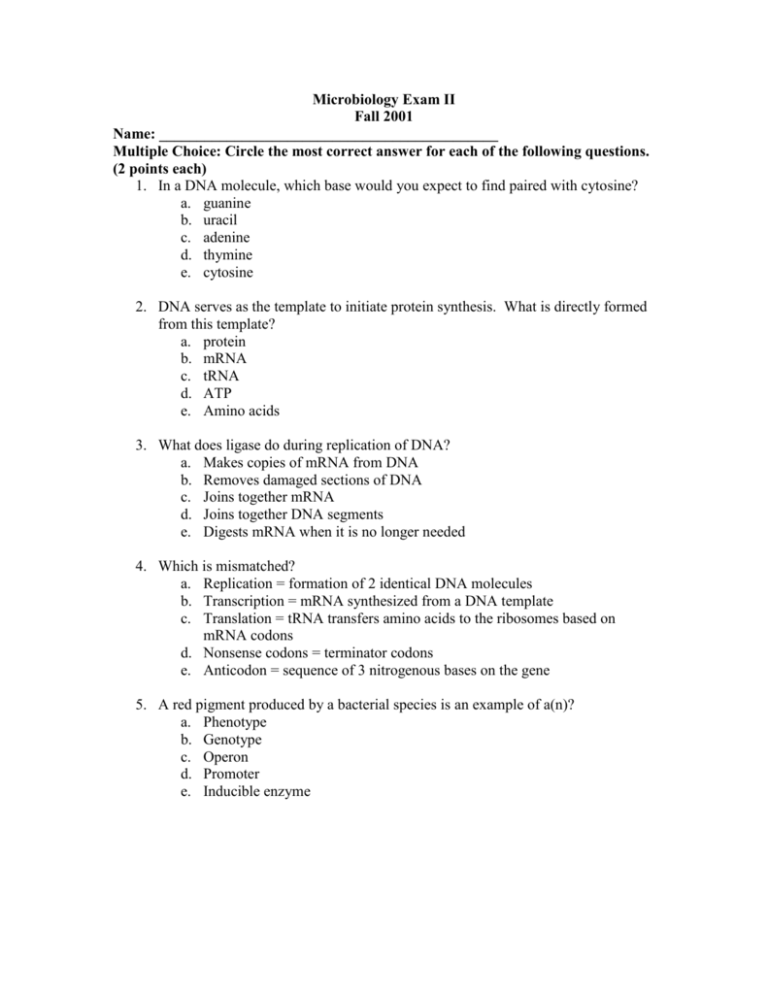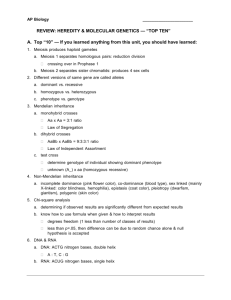Microbiology Exam II - University of Evansville Faculty Web sites
advertisement

Microbiology Exam II Fall 2001 Name: _____________________________________________ Multiple Choice: Circle the most correct answer for each of the following questions. (2 points each) 1. In a DNA molecule, which base would you expect to find paired with cytosine? a. guanine b. uracil c. adenine d. thymine e. cytosine 2. DNA serves as the template to initiate protein synthesis. What is directly formed from this template? a. protein b. mRNA c. tRNA d. ATP e. Amino acids 3. What does ligase do during replication of DNA? a. Makes copies of mRNA from DNA b. Removes damaged sections of DNA c. Joins together mRNA d. Joins together DNA segments e. Digests mRNA when it is no longer needed 4. Which is mismatched? a. Replication = formation of 2 identical DNA molecules b. Transcription = mRNA synthesized from a DNA template c. Translation = tRNA transfers amino acids to the ribosomes based on mRNA codons d. Nonsense codons = terminator codons e. Anticodon = sequence of 3 nitrogenous bases on the gene 5. A red pigment produced by a bacterial species is an example of a(n)? a. Phenotype b. Genotype c. Operon d. Promoter e. Inducible enzyme 6. Which of the following best describes a plasmid? a. A gene within the chromosome b. Small circular piece of DNA outside the chromosome c. The genetic material of a bacteriophage d. Part of bacterial ribosomes e. A single, linear strand of DNA 7. Which of the following is NOT involved in bacterial conjugation? a. Bacteriophage b. F+ cells c. F- cells d. Plasmids e. Sex pili 8. What was one of the first and most useful microscopic tests for classifying bacteria that is still important today? a. Gram stain b. Flagella stains c. Simple stains d. Negative stain for capsule e. Metachromatic granule stain 9. Which is NOT true of virus capsids? a. They surround and protect viral nucleic acid b. Always icosahedral in shape c. Remain outside of host bacterial cells while the nucleic acid is injected into the bacterial cell d. Enters host animal cells together with the nucleic acid e. Made up of protein subunits called capsomeres 10. Which pertains to viruses? a. Are prokaryotic b. Have 70S ribosomes c. All contain DNA and RNA d. Too small to be seen with a light microscope e. Are free-living saprophytes 11. Which is NOT true of viruses? a. Are obligate intracellular parasites b. Can be destroyed with antibiotics c. Can be observed with an electron microscope d. Are acellular e. Replicate only inside host cells 12. Which of the following is the BEST method to determine bacteriophage concentration in a sample? a. Spectrophotometer b. Plaque assay c. Light microscope d. Animal inoculation e. Biochemical tests 13. Which of the following is NOT used to classify viruses? a. Presence or absence of envelope b. Shape of capsid c. Type of nucleic acid d. Host range e. Biochemical reactions 14. The mechanism whereby an enveloped virus leaves a host cell is called? a. Transduction b. Budding c. Teratogenesis d. Lysogeny e. Penetration 15. Absence of all life forms: a. Clean b. Disinfected c. Sterile d. Aseptic e. Sanitized 16. Which is mismatched? a. Bacteriostatic = kill vegetative bacterial cells b. Germicide = kills microbes c. Viricide = inactivates viruses d. Sporicide = kills bacterial endospores and fungal spores e. Fungicide = kills yeasts and molds 17. If you were asked to sterilize a heat sensitive item which of the following would be most suitable? a. Steam autoclave b. Pasteurization c. Ethylene oxide d. Ethyl alcohol e. Hot air oven 18. A useful method or compound for sterilizing foods such as fresh vegetables: a. Ionizing radiation b. Ultraviolet light c. Steam autoclave d. Phenols e. Formaldehyde 19. Which of the following is commonly used to prepare incision sites for surgery and as a surgical scrub? a. Ethyl alcohol b. Hydrogen peroxide c. Iodophor d. Glutaraldehyde e. Lysol 20. The chemical in bleach responsible for antimicrobial activity: a. Iodine b. Phenol c. Chlorine d. Zinc e. Glutaraldehyde 21. Which pertains to antibiotics? a. Chemicals produced by one microorganism that inhibits other microorganisms b. Can only interfere with cell wall synthesis of the pathogen c. Completely synthesized in the laboratory d. Always has toxic side-effects for the patient e. Also called semi-synthetics 22. Which does not pertain to broad-spectrum drugs? a. Often used when the pathogen has not been identified b. Can also kill or inhibit the patient’s normal flora c. Include oral penicillin and tetracycline d. Can only kill Gram+ bacteria e. Should not be used if pathogen’s identity is known and a narrow-spectrum drug is available 23. Which of the following is not true of both natural penicillins and first generation cephalosporins? a. Contain a beta-lactam ring b. Come from molds c. Damage bacterial cytoplasmic membranes d. Easily modified e. Can be inactivated by beta-lactamases 24. Sulfonamides can best be described as: a. Antimetabolites b. Antiviral agents c. Containing a beta-lactam ring d. Aminoglycosides e. Inhibiting cell wall synthesis True or False: Place a T or F in front of each of the following. (2 points each) 25. Transcription is the process of making RNA from a DNA template. 26. The most common type of control in bacterial is transcriptional. 27. A repressor controls the lactose operon. 28. Mutations always affect the genotype. 29. Prions only contain RNA. 30. Reverse transcriptase can make DNA using an RNA template. 31. The Ames test is used to test for viral infection. 32. Pasteurization is used to sterilize milk products. 33. Aminoglycosides are bacteriostatic antibiotics. 34. Quinolones affect the replication of DNA. 35. AZT is a nucleotide analog used to combat viral infections. Essay Questions: Use the provided space to answer each of the following questions. 36. Name the three types of RNA and describe their functions. (6 points) 37. Define operon. (2 points) 38. List the four possible outcomes of an animal virus infection. (4 points) 39. List the three ways genetic material can be exchange between on bacterium to another. Describe one way in detail. (5 points) 40. Name and very briefly describe the steps in a lytic bacteriophage infection. (7 points) 41. State the difference between the following: silent, nonsense, and missense mutations. (3 points) 42. Describe in as much detail as possible DNA replication OR protein translation. Use the proper terms for the enzymes (proteins) involved. (8 points) 43. Compare antibiotics and growth factor analogs in regards to mode of actions, host range, side-effects, origin, and definition. (8 points) 44. For an antibiotic to be affective, what considerations must be made to use it in humans? (4 points) 45. What is the difference between a lytic and lysogenic infection? (3 points)






